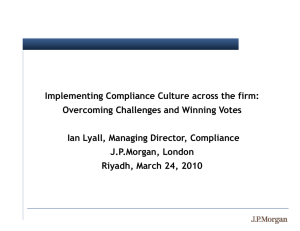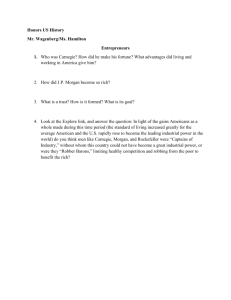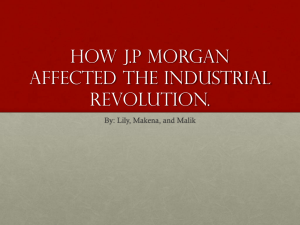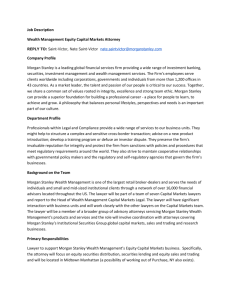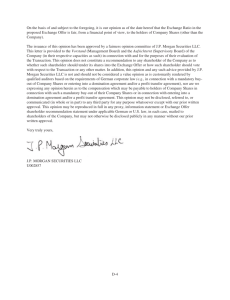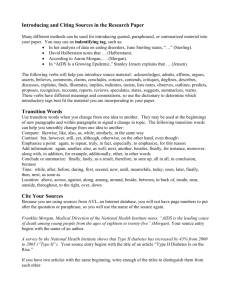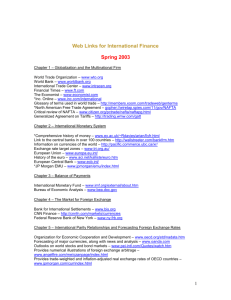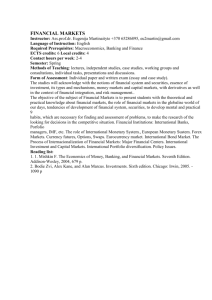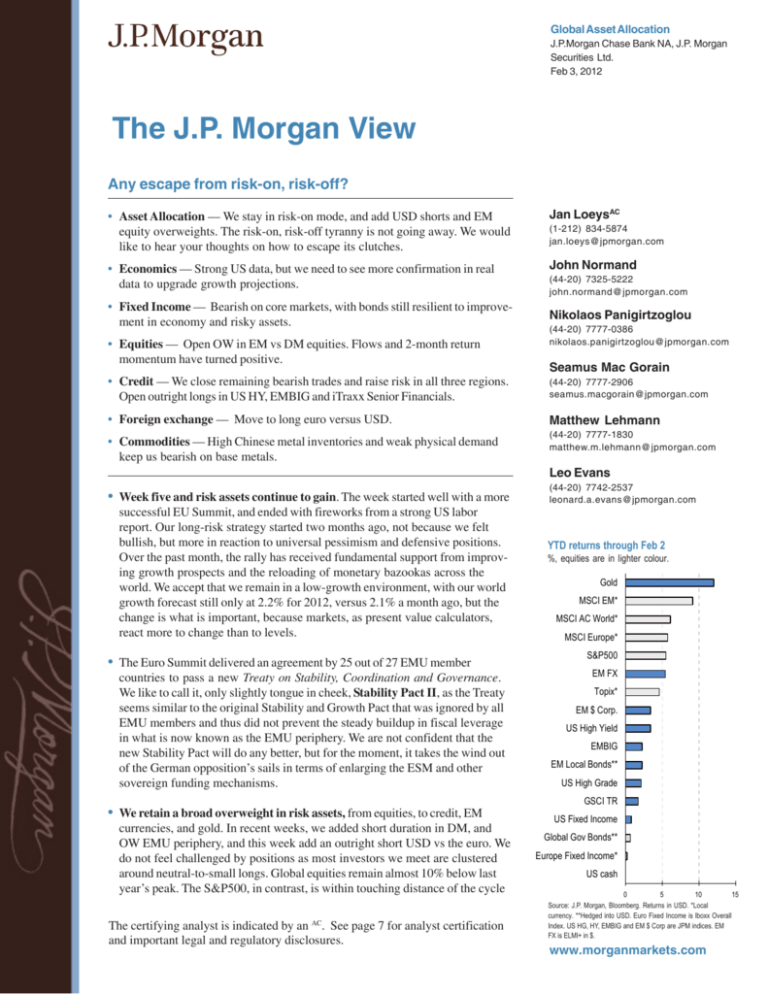
Global Asset Allocation
J.P.Morgan Chase Bank NA, J.P. Morgan
Securities Ltd.
Feb 3, 2012
The J.P. Morgan View
Any escape from risk-on, risk-off?
• Asset Allocation –– We stay in risk-on mode, and add USD shorts and EM
equity overweights. The risk-on, risk-off tyranny is not going away. We would
like to hear your thoughts on how to escape its clutches.
Jan LoeysAC
• Economics –– Strong US data, but we need to see more confirmation in real
data to upgrade growth projections.
John Normand
• Fixed Income –– Bearish on core markets, with bonds still resilient to improvement in economy and risky assets.
• Equities –– Open OW in EM vs DM equities. Flows and 2-month return
momentum have turned positive.
• Credit –– We close remaining bearish trades and raise risk in all three regions.
Open outright longs in US HY, EMBIG and iTraxx Senior Financials.
• Foreign exchange –– Move to long euro versus USD.
• Commodities –– High Chinese metal inventories and weak physical demand
keep us bearish on base metals.
(1-212) 834-5874
jan.loeys@jpmorgan.com
(44-20) 7325-5222
john.normand@jpmorgan.com
Nikolaos Panigirtzoglou
(44-20) 7777-0386
nikolaos.panigirtzoglou@jpmorgan.com
Seamus Mac Gorain
(44-20) 7777-2906
seamus.macgorain@jpmorgan.com
Matthew Lehmann
(44-20) 7777-1830
matthew.m.lehmann@jpmorgan.com
Leo Evans
• Week five and risk assets continue to gain. The week started well with a more
successful EU Summit, and ended with fireworks from a strong US labor
report. Our long-risk strategy started two months ago, not because we felt
bullish, but more in reaction to universal pessimism and defensive positions.
Over the past month, the rally has received fundamental support from improving growth prospects and the reloading of monetary bazookas across the
world. We accept that we remain in a low-growth environment, with our world
growth forecast still only at 2.2% for 2012, versus 2.1% a month ago, but the
change is what is important, because markets, as present value calculators,
react more to change than to levels.
• The Euro Summit delivered an agreement by 25 out of 27 EMU member
countries to pass a new Treaty on Stability, Coordination and Governance.
We like to call it, only slightly tongue in cheek, Stability Pact II, as the Treaty
seems similar to the original Stability and Growth Pact that was ignored by all
EMU members and thus did not prevent the steady buildup in fiscal leverage
in what is now known as the EMU periphery. We are not confident that the
new Stability Pact will do any better, but for the moment, it takes the wind out
of the German opposition’s sails in terms of enlarging the ESM and other
sovereign funding mechanisms.
• We retain a broad overweight in risk assets, from equities, to credit, EM
currencies, and gold. In recent weeks, we added short duration in DM, and
OW EMU periphery, and this week add an outright short USD vs the euro. We
do not feel challenged by positions as most investors we meet are clustered
around neutral-to-small longs. Global equities remain almost 10% below last
year’s peak. The S&P500, in contrast, is within touching distance of the cycle
The certifying analyst is indicated by an AC. See page 7 for analyst certification
and important legal and regulatory disclosures.
(44-20) 7742-2537
leonard.a.evans@jpmorgan.com
YTD returns through Feb 2
%, equities are in lighter colour.
Gold
MSCI EM*
MSCI AC World*
MSCI Europe*
S&P500
EM FX
Topix*
EM $ Corp.
US High Yield
EMBIG
EM Local Bonds**
US High Grade
GSCI TR
US Fixed Income
Global Gov Bonds**
Europe Fixed Income*
US cash
0
5
10
15
Source: J.P. Morgan, Bloomberg. Returns in USD. *Local
currency. **Hedged into USD. Euro Fixed Income is Iboxx Overall
Index. US HG, HY, EMBIG and EM $ Corp are JPM indices. EM
FX is ELMI+ in $.
www.morganmarkets.com
Global Asset Allocation
The J.P. Morgan View
peak (April 2011), but rolling EPS is up 10% in the meanwhile, thus not making
us worried about value exhaustion. In our monthly GMOS (Feb 2), we moved
to an overweight of EM equities on momentum in prices and flows. We
switched from UW European credit to OW (senior bank debt), but refrain from
going OW European equities vs the US, as EMU event risk has not gone
away.
• Where are the risks? The Greek debt restructuring talks are getting more
complicated and less voluntary. We think the market and we are prepared for
the messy and involuntary, but not the chaotic, where Greece just walks away.
In the US, we still need to get the payroll tax cut and unemployment benefits
extended beyond this month. We think both sides of the aisle are willing and
able to agree to this extension, but we will likely see this only decided at the
last minute (end of this month).
• One growing problem for all market participants is the rising tyranny of global
risk-on, risk-off, or the fact that all risk assets –– equities, credit, commodities, EM, and the dollar reversed –– are trading as a single asset class. That is,
we are either in risk-on or risk-off. Once you have that choice right, most other
aspects of investing –– selection of region, sector, product and security –– do
not matter anymore as they all trade on their risk-beta. The second chart
shows that the correlation across risk asset classes has been rising for almost
a decade, and is now even higher than during the Lehman crisis. Many forces
have contributed to this, but most come down to the increasing convergence
in objectives, constraints and behavior of global corporates, policy makers,
and investment managers. Each of these three operate in the same way, are
trying to achieve the same objectives, are sharing the same information, and
are making the same mistakes at the same time. That will not go away. Hence,
there is no escape. You have to take a stance on whether you are in risk-on or
risk-off.
2012 global GDP growth forecasts: JPMorgan
and Consensus
%
4.0
3.5
Consensus
3.0
2.5
JPM
2.0
1.5
Jan-11
Apr-11
Jun-11
Sep-11
Dec-11
Source: J.P. Morgan, Consensus Economics. Consensus Economics
forecasts are for regions and countries that we averaged using the
same 5-year rolling USD GDP weights that we use for our own global
growth forecast.
Average correlation between risky assets
Average pairwise correlation of monthly returns
between S&P500, DXY (inverse), GSCI, EM FX,
MSCI EM and US HY credit.
0.8
0.7
0.6
0.5
0.4
0.3
0.2
0.1
0
-0.1
• Some diversification, tactical and strategic, is still possible, though. For one,
bond duration is not yet the mirror image of risk-on. In addition, beyond the
cyclical/defensive divide, managers can still pursue beta-neutral sector and
security selection trades. Beyond these, we would like to invite from you, our
readers, to send your ideas on how to escape the risk-on, risk-off tyranny to
jan.loeys@jpmorgan.com. I will summarise your suggestions in one of the next
few weeks.
Fixed income
• Bonds shifted lower, but are still proving fairly resilient to the equity rally and
the better tone in macro data. We retain value-based shorts in the UK, Germany and the US, where long bond manager positioning is also supportive of
higher yields. Even so, it is difficult to envisage a significant bear market with
monetary policy so supportive. Indeed, we expect another £50bn from the
Bank of England next week (down from £75bn, in the light of the better
economic outlook). We also expect Euro area peripheral spreads to continue
to tighten near term, if not at the breakneck pace of the past few months, with
Greece the principal risk to this view.
99 00 01 02 03 04 05 06 07 08 09 10 11
Source: Bloomberg, J.P.Morgan
More details in ...
Global Data Watch, Bruce Kasman and David Hensley
Global Markets Outlook and Strategy, Jan Loeys, Bruce
Kasman, et al.
US Fixed Income Markets, Terry Belton and Srini
Ramaswamy
Global Fixed Income Markets, Pavan Wadhwa and Fabio
Bassi
Emerging Markets Outlook and Strategy, Joyce Chang
Key trades and risk: Emerging Market Equity Strategy,
Adrian Mowat et al.
Flows and Liquidity, Nikos Panigirtzoglou et al.
Feb 3, 2012
2
Global Asset Allocation
The J.P. Morgan View
• A challenge for investors positioning for yields to correct from their historically low levels is to identify bearish trades without onerous negative carry.
One option is weighted curve steepeners, with the long money market leg
chosen so as to bring positive carry. See GFIMS Euro Derivatives for details.
• The Eurozone crisis has brought some renewed focus on Japanese sovereign
risk, though JGBs have remained rock-solid at sub-1% yields. We expect
Japan’s current account to fall into deficit by 2015, requiring foreigners to
finance the fiscal deficit, but see a gradual rise in JGB yields, towards 2%, as
more likely than a sharp shock. See Takafumi Yamawaki, What if Japan’s
current account falls into deficit?, 3 Feb, for the best ways to position for
this.
Equities
• Stay long and add exposure to EM equities. Investors are returning to EM, as
suggested by the $11bn injected into EM equity funds in January. Although
we recognize that there is a significant beta element to overweighting EM vs
DM equities, we take encouragement from our EM vs. DM 2-month
momentum trading strategy, which has switched to an overweight.
US convertible bonds vs. S&P500
Total return index
1.16
1.14
1.12
1.10
1.08
1.06
1.04
1.02
1.00
Feb-10
Jul-10
Dec-10
May-11
Oct-11
Source: Datastream, J.P. Morgan
• The Greek PSI and a potential disappointment with the take up of Feb’s 3y
LTRO represent the main near-term risks. OW US equities is an efficient way
to protect an equity portfolio against these events.
• OW German vs. Euro area equities performed strongly in January. This trade
can work well even in a bearish environment. The DAX outperformed the
Eurostoxx50 index during the market selloffs of both early September and
early November, despite the difficulty that the short sale ban creates in
directly implementing this trade.
• The increase in the global PMI index in January keeps us comfortably long
Cyclical vs. Defensive sectors. See REVISITING: Using the Global PMI as
trading signal, N. Panigirtzoglou, Jan 12). The 2-month change in the global
manufacturing PMI is the signal we follow to trade Cyclical vs Defensive
equity sectors.
• Convertible bonds posted a strong gain in January. We stay long as US
convertible bonds are still at the bottom of their 2-year range vs. the
S&P500 (top chart). Convertible bonds are hybrid instruments with debt and
equity-like features. As an asset class they benefit from both the rally in
equities and credit.
Credit
• Spreads continue to rally unabated. Through January, in local currency terms,
EU HY saw 6% returns, US HY and EM $ corps saw 3% returns, EU HG, US HG
and EM $ sovereigns all saw near 2% returns; more than the average January
by a factor of up to 3. European credit is outperforming the US, the catalyst
for which has been two-fold. 1) The surprising impact of the LTRO and 2) the
resolve for EU decision makers to move some form of fiscal compact forward.
• In this week’s GMOS we outlined a change in strategy in our credit portfolio.
Events risk still lies ahead on the road in Europe, but tail risks relating to bank
Feb 3, 2012
More details in ...
EM Corporate Outlook and Strategy, Warren Mar et al.
US Credit Markets Outlook and Strategy, Eric Beinstein et al.
High Yield Credit Markets Weekly, Peter Acciavatti et al.
European Credit Outlook & Strategy, Steven Dulake et al.
Emerging Markets Cross Product Strategy Weekly, Eric
Beinstein et al.
3
Global Asset Allocation
The J.P. Morgan View
funding have surely subsided. In the low interest rate, low(ish) growth rate
and low default rate we envisage in H1, credit is an attractive sector in which
to add risk. As such, we raise our risk profile in all three regions by closing our
remaining bearish trades, reducing our overweights in US vs. Euro credit to
market weight, and adding outright longs in EMBIG and iTraxx Senior
Financials to our preferred sector, US HY (see yesterday’s GMOS).
Foreign Exchange
• Currencies are entering February with extraordinary momentum. The dollar is
down almost 3% trade-weighted and versus every currency in the world bar
Argentina. Its decline has been particularly precipitous versus emerging
markets, where rallies in currencies such as HUF, INR and MYR over the past
month exceed two sigmas. The reasons are well known – extraordinary ECB
liquidity, unusual Fed transparency and a global upturn in activity data. We
argued last week that this environment could create a carry trade revival (i.e.
across-the-board USD weakness) comparable to 2009 were it not for the event
risks from a clumsy Greek PSI deal. Those risks remain but are looking like a
speedbump rather than a roadblock given how broadly activity data are rising.
Increase USD shorts again this week but avoid the commodity currencies,
which are showing the clearest signs of overshooting.
FX weekly change vs USD
2%
1%
0%
-1%
USD EUR GBP JPY CHF CAD AUD
TWI
Source: J.P. Morgan
• In the macro portfolio, add long EUR/USD to existing shorts in USD/SEK
(cash) and USD/JPY (options). Take profits on long EUR/GBP but stay short
GBP/NOK and long NOK/SEK. Also take profits on EUR/NOK range binary. In
the derivatives portfolio, hold straddles on GBP/USD (2-yr) and EUR/CAD (1yr) outright, and NZD/USD vs USD/CLP vol swaps (3-mo). Hold risk reversals
in EUR/USD (6-mo) and EUR/JPY (6-mo). Sell calls on USD/TRY (6-mo) and
hold a suite of long high-beta G-10 vol vs. short LatAm vol spreads in relative
value. In the technical portfolio, stay short EUR/KRW, NZD/CAD, PLN/HUF
and EUR/INR.
Commodities
• Commodities fell slightly this week as base metals gave back some of their
recent gains. Our Metals analyst has slightly lowered his forecasts across
metals this week. We now expect copper prices to average around $8000/mt
over the first quarter which means prices should fall from current levels
(Metals Review and Outlook, Michael Jansen, 30 Jan). Both the LME and
Shanghai copper curves are in contango (upward sloping), suggesting ample
inventories and physical premia (spot vs. futures) are at multi month lows,
suggesting weak physical demand. We would need to see Chinese inventories
start to draw down before we change our bearish view. The latest data point on
Chinese inventories was out yesterday and showed a further inventory build.
• Energy also fell this week but this masks a renewed divergence between the
price of Brent and WTI. The spread between the two widened out to $16/bbl
from only $8/bbl at the end of last year. Brent/WTI should reflect the marginal
cost of moving oil from Cushing (where WTI is priced) to the US Gulf Coast.
However, storage capacity has increased over the last few months which
means there is now the option of storing the oil and shipping it later in the
year when costs will be lower due to the reversal of a pipeline which will allow
oil to flow south from Cushing.
More details in ...
FX Markets Weekly, John Normand et al.
Commodity Markets Outlook & Strategy, Colin
Fenton et al.
Oil Markets Monthly, Lawrence Eagles et al.
Metals Review and Outlook, Michael Jansen
Global Metals Quarterly, Michael Jansen
Feb 3, 2012
4
Global Asset Allocation
The J.P. Morgan View
Interest rates
United States
Euro area
Current
Mar-12
Jun-12
Sep-12
Dec-12
Fed funds rate
0.125
0.125
0.125
0.125
0.125
10-year yields
1.94
2.25
2.50
2.50
2.50
Refi rate
1.00
0.75
0.50
0.50
0.50
10-year yields
1.93
2.15
2.00
1.95
1.90
United Kingdom
Repo rate
0.50
0.50
0.50
0.50
0.50
10-year yields
2.18
2.25
2.10
2.00
2.00
Japan
Overnight call rate
0.05
0.05
0.05
0.05
0.05
10-year yields
0.95
0.90
0.95
1.10
1.15
GBI-EM hedged in $
Yield - Global Diversified
6.22
6.70
Credit Markets
Current
YTD Return*
0.3%
-0.2%
-1.0%
0.2%
2.3%
Index
YTD Return*
US high grade (bp over UST)
211
JPMorgan JULI Porfolio Spread to Treasury
2.2%
Euro high grade (bp over Euro gov)
297
iBoxx Euro Corporate Index
2.5%
USD high yield (bp vs. UST)
673
JPMorgan Global High Yield Index STW
3.1%
Euro high yield (bp over Euro gov)
899
iBoxx Euro HY Index
7.5%
EMBIG (bp vs. UST)
412
EMBI Global
2.3%
EM Corporates (bp vs. UST)
431
JPM EM Corporates (CEMBI)
3.5%
Quarterly Averages
Commodities
Current
12Q1
12Q2
12Q3
12Q4
Brent ($/bbl)
113
105
110
115
120
Energy
2.0%
Gold ($/oz)
1742
1725
1825
1900
1925
Precious Metals
12.1%
Copper ($/metric ton)
8322
8000
8500
8875
9000
Industrial Metals
9.4%
Corn ($/Bu)
6.40
6.70
7.00
6.80
6.30
Agriculture
0.7%
Current
Mar-12
Jun-12
Sep-12
Dec-12
EUR/USD
1.31
1.30
1.34
1.36
1.38
EUR
1.7%
USD/JPY
76.5
76
76
74
72
JPY
1.1%
Foreign Exchange
GSCI Index
YTD Return*
3m cash YTD Return*
index
in USD
GBP/USD
1.58
1.54
1.56
1.57
1.58
GBP
2.0%
USD/BRL
1.72
1.87
1.85
1.81
1.80
BRL
9.3%
USD/CNY
6.30
6.23
6.15
6.10
6.05
CNY
0.7%
USD/KRW
1118
1120
1080
1060
1040
KRW
3.2%
USD/TRY
1.75
1.88
1.85
1.80
1.80
TRY
8.4%
YTD Return
Equities
Current
(local ccy)
Sector Allocation *
US
Europe
Japan
EM
YTD
YTD
YTD
YTD ($)
18.8%
S&P
1344
7.0%
Energy
2.5%
1.3%
0.8%
Nasdaq
2907
11.3%
Materials
11.8%
15.1%
4.1%
18.9%
Topix
761
4.4%
Industrials
8.1%
9.1%
6.0%
17.5%
FTSE 100
5901
6.0%
Discretionary
6.1%
13.4%
7.7%
10.9%
MSCI Eurozone*
142
8.2%
Staples
-0.5%
-2.1%
0.1%
7.2%
MSCI Europe*
1084
5.8%
Healthcare
3.8%
-0.9%
-0.2%
12.3%
MSCI EM $*
1044
14.1%
Financials
10.5%
14.2%
14.1%
16.3%
Brazil Bovespa
65505
15.4%
Information Tech.
8.9%
6.4%
0.5%
11.8%
Hang Seng
20757
14.8%
Telecommunications
-2.0%
-2.8%
-2.8%
4.9%
Shanghai SE
2330
7.2%
Utilities
-3.5%
1.2%
-1.6%
10.1%
Overall
7.0%
5.8%
4.4%
14.1%
*Levels/returns as of Feb 02, 2012
Local currency except MSCI EM $
Source: Bloomberg, Datastream, IBES, Standard & Poor's Services, J.P. Morgan estimates
Feb 3, 2012
5
Global Asset Allocation
The J.P. Morgan View
Global Economic Outlook Summary
Real GDP
Real GDP
% over a year ago
Consumer prices
% over previous period, saar
% over a year ago
2011
2012
2013
3Q11
4Q11
1Q12
2Q12
3Q12
4Q12
1Q13
4Q11
2Q12
4Q12
2Q13
The Americas
United States
Canada
Latin America
Argentina
Brazil
Chile
Colombia
Ecuador
Mexico
Peru
Venezuela
1.7
2.3
4.3
9.2
2.8
6.3
5.7
8.0
4.0
6.7
4.0
2.3
2.2
3.4
3.2
3.1
4.0
4.0
4.0
3.3
4.5
4.0
2.2
2.5
4.1
5.5
4.5
4.8
5.0
4.0
3.5
7.0
1.0
1.8
3.5
3.2
4.5
-0.2
2.6
7.1
7.1
5.5
6.5
6.8
2.8
1.7
2.5
6.5
1.5
2.1
2.8
1.0
2.8
2.7
2.5
2.0
2.1
2.7
0.0
2.6
4.0
2.8
2.0
2.5
2.4
6.0
2.5
2.6
5.1
2.0
5.7
4.5
3.7
3.5
5.5
4.1
6.0
3.0
2.3
3.7
3.0
5.5
6.0
3.9
4.0
0.6
6.5
4.0
2.0
2.4
3.5
4.0
5.7
6.0
4.1
4.0
1.0
7.6
-3.0
1.5
2.7
4.6
6.0
4.5
4.5
5.5
4.0
5.0
8.5
0.0
3.3
2.8
7.2
9.5
6.7
3.6
3.9
5.5
3.5
4.5
28.8
1.8
1.7
6.5
10.0
5.1
3.6
3.0
5.3
3.5
4.1
29.1
1.4
1.7
6.6
11.0
5.1
3.4
2.9
4.7
3.5
2.8
30.3
1.4
2.0
7.1
11.0
5.0
3.2
3.0
4.7
3.8
2.9
36.5
Asia/Pacific
Japan
Australia
New Zealand
Asia ex Japan
China
Hong Kong
India
Indonesia
Korea
Malaysia
Philippines
Singapore
Taiwan
Thailand
-0.9
1.9
1.7
7.0
9.2
5.0
7.0
6.3
3.6
4.0
3.7
4.9
4.0
1.0
1.3
3.1
2.5
6.5
8.4
3.0
7.3
5.2
3.3
2.0
3.8
1.2
2.9
5.2
1.3
3.2
2.9
7.2
9.1
4.2
8.0
5.4
4.0
3.2
4.8
5.2
5.1
3.5
5.6
3.9
3.2
6.3
8.4
0.4
7.5
6.2
3.3
5.8
3.4
1.9
-0.8
2.1
-0.6
1.8
2.9
5.1
9.2
1.2
6.5
5.5
1.4
0.0
3.5
-4.9
-1.0
-25.0
1.8
2.8
1.0
6.7
7.2
2.5
6.7
5.0
3.0
2.5
2.8
-0.4
3.3
35.0
1.0
2.9
4.4
6.8
7.8
4.0
7.2
4.5
4.0
1.0
4.9
7.4
4.8
15.0
1.2
3.5
2.4
7.5
9.5
5.5
7.7
5.0
4.5
2.0
5.7
6.1
5.8
2.0
1.2
3.7
1.8
7.8
10.0
6.0
8.0
5.0
5.0
2.5
4.9
6.1
6.5
0.5
1.2
3.3
1.0
7.3
9.1
3.0
8.3
5.5
4.0
4.0
4.5
4.5
4.5
5.0
-0.1
3.8
2.9
4.9
4.6
5.7
9.0
3.2
4.0
2.4
4.7
5.4
1.4
3.5
-0.5
3.2
2.2
3.9
3.0
4.5
8.5
3.6
3.4
1.5
3.9
3.9
1.3
2.8
-0.5
3.3
2.5
3.8
3.1
3.6
7.8
4.0
3.5
1.3
4.0
3.0
1.7
1.4
-0.4
3.0
2.7
4.1
3.9
3.2
7.6
4.0
3.5
1.4
4.0
3.0
1.2
1.4
Africa/Middle East
Israel
South Africa
4.3
3.1
2.9
2.7
4.4
3.6
3.5
1.4
1.3
3.9
0.8
2.3
3.2
2.6
6.1
2.8
7.4
3.2
4.5
3.8
2.8
6.1
2.3
6.0
2.5
6.2
2.1
5.9
Europe
Euro area
Germany
France
Italy
Norway
Sweden
United Kingdom
Emerging Europe
Bulgaria
Czech Republic
Hungary
Poland
Romania
Russia
Turkey
1.5
3.0
1.6
0.3
2.5
4.7
0.9
4.8
2.2
1.9
1.5
4.3
2.7
4.3
8.2
-0.4
0.6
-0.1
-1.8
1.1
1.1
0.6
2.7
2.5
0.5
0.5
2.7
0.8
3.5
2.5
0.3
1.3
0.3
-0.7
1.8
1.7
1.9
3.5
3.3
1.7
1.5
3.0
2.7
3.7
4.5
0.5
2.0
1.2
-0.6
3.4
6.6
2.3
3.5
…
-0.3
2.2
4.1
7.4
3.5
…
-1.0
-1.0
-0.5
-2.5
1.0
1.0
-0.8
4.6
…
-0.3
-0.3
3.0
-0.5
7.0
…
0.0
1.0
0.0
-2.5
0.0
-0.5
1.0
2.0
…
0.0
-0.3
2.0
-1.2
3.0
…
-1.5
0.0
-1.0
-2.5
0.0
-0.5
-1.0
1.2
…
0.8
0.3
2.0
-1.5
1.5
…
-0.3
1.0
0.0
-1.0
1.0
0.5
2.5
2.5
…
2.0
1.0
2.5
0.8
3.0
…
0.3
1.0
0.0
-1.0
1.0
1.0
1.5
3.7
…
2.0
2.0
3.0
2.4
4.5
…
0.5
1.5
0.5
-0.5
2.0
2.0
2.0
3.3
…
1.5
1.5
3.0
2.5
4.0
…
3.0
2.6
2.6
3.7
1.2
2.5
4.6
6.3
…
2.4
4.1
4.6
3.5
6.8
9.0
2.0
1.7
2.1
2.9
1.2
1.2
2.5
4.9
…
2.7
4.9
3.3
3.3
4.4
8.1
1.8
1.6
1.6
3.2
1.4
1.1
2.0
5.4
…
2.9
5.1
3.3
4.4
6.3
6.2
1.6
1.4
1.2
2.8
1.7
1.5
1.8
5.9
…
2.5
3.6
2.9
4.0
6.8
7.9
Global
Developed markets
Emerging markets
2.6
1.3
5.8
2.2
1.2
4.9
2.6
1.5
5.7
2.9
2.1
5.0
1.7
0.7
4.3
2.2
1.2
4.8
1.9
0.7
5.4
2.7
1.6
5.6
2.6
1.3
6.0
2.5
1.3
5.9
3.6
2.8
5.7
2.5
1.7
4.7
2.3
1.4
4.8
2.4
1.3
5.2
Source: J.P. Morgan
Feb 3, 2012
6
Global Asset Allocation
The J.P. Morgan View
Analyst Certification: The research analyst(s) denoted by an “AC” on the cover of this report certifies (or, where multiple
research analysts are primarily responsible for this report, the research analyst denoted by an “AC” on the cover or
within the document individually certifies, with respect to each security or issuer that the research analyst covers in this
research) that: (1) all of the views expressed in this report accurately reflect his or her personal views about any and all
of the subject securities or issuers; and (2) no part of any of the research analyst’s compensation was, is, or will be
directly or indirectly related to the specific recommendations or views expressed by the research analyst(s) in this report.
Other Disclosures
J.P. Morgan (“JPM”) is the global brand name for J.P. Morgan Securities LLC (“JPMS”) and its affiliates worldwide. J.P. Morgan Cazenove is a
marketing name for the U.K. investment banking businesses and EMEA cash equities and equity research businesses of JPMorgan Chase & Co.
and its subsidiaries.
Options related research: If the information contained herein regards options related research, such information is available only to
persons who have received the proper option risk disclosure documents. For a copy of the Option Clearing Corporation’s Characteristics and
Risks of Standardized Options, please contact your J.P. Morgan Representative or visit the OCC’s website at http://www.optionsclearing.com/
publications/risks/riskstoc.pdf
Legal Entities Disclosures
U.S.: JPMS is a member of NYSE, FINRA, SIPC and the NFA. JPMorgan Chase Bank, N.A. is a member of FDIC and is authorized and
regulated in the UK by the Financial Services Authority. U.K.: J.P. Morgan Securities Ltd. (JPMSL) is a member of the London Stock
Exchange and is authorized and regulated by the Financial Services Authority. Registered in England & Wales No. 2711006. Registered Office
125 London Wall, London EC2Y 5AJ. South Africa: J.P. Morgan Equities Limited is a member of the Johannesburg Securities Exchange and
is regulated by the FSB. Hong Kong: J.P. Morgan Securities (Asia Pacific) Limited (CE number AAJ321) is regulated by the Hong Kong
Monetary Authority and the Securities and Futures Commission in Hong Kong. Korea: J.P. Morgan Securities (Far East) Ltd, Seoul Branch, is
regulated by the Korea Financial Supervisory Service. Australia: J.P. Morgan Australia Limited (ABN 52 002 888 011/AFS Licence No:
238188) is regulated by ASIC and J.P. Morgan Securities Australia Limited (ABN 61 003 245 234/AFS Licence No: 238066) is a Market
Participant with the ASX and regulated by ASIC. Taiwan: J.P.Morgan Securities (Taiwan) Limited is a participant of the Taiwan Stock
Exchange (company-type) and regulated by the Taiwan Securities and Futures Bureau. India: J.P. Morgan India Private Limited, having its
registered office at J.P. Morgan Tower, Off. C.S.T. Road, Kalina, Santacruz East, Mumbai - 400098, is a member of the National Stock
Exchange of India Limited (SEBI Registration Number - INB 230675231/INF 230675231/INE 230675231) and Bombay Stock Exchange
Limited (SEBI Registration Number - INB 010675237/INF 010675237) and is regulated by Securities and Exchange Board of India. Thailand:
JPMorgan Securities (Thailand) Limited is a member of the Stock Exchange of Thailand and is regulated by the Ministry of Finance and the
Securities and Exchange Commission. Indonesia: PT J.P. Morgan Securities Indonesia is a member of the Indonesia Stock Exchange and is
regulated by the BAPEPAM LK. Philippines: J.P. Morgan Securities Philippines Inc. is a member of the Philippine Stock Exchange and is
regulated by the Securities and Exchange Commission. Brazil: Banco J.P. Morgan S.A. is regulated by the Comissao de Valores Mobiliarios
(CVM) and by the Central Bank of Brazil. Mexico: J.P. Morgan Casa de Bolsa, S.A. de C.V., J.P. Morgan Grupo Financiero is a member of the
Mexican Stock Exchange and authorized to act as a broker dealer by the National Banking and Securities Exchange Commission. Singapore:
This material is issued and distributed in Singapore by J.P. Morgan Securities Singapore Private Limited (JPMSS) [MICA (P) 032/01/2012 and
Co. Reg. No.: 199405335R] which is a member of the Singapore Exchange Securities Trading Limited and is regulated by the Monetary
Authority of Singapore (MAS) and/or JPMorgan Chase Bank, N.A., Singapore branch (JPMCB Singapore) which is regulated by the MAS.
Malaysia: This material is issued and distributed in Malaysia by JPMorgan Securities (Malaysia) Sdn Bhd (18146-X) which is a Participating
Organization of Bursa Malaysia Berhad and a holder of Capital Markets Services License issued by the Securities Commission in Malaysia.
Pakistan: J. P. Morgan Pakistan Broking (Pvt.) Ltd is a member of the Karachi Stock Exchange and regulated by the Securities and Exchange
Commission of Pakistan. Saudi Arabia: J.P. Morgan Saudi Arabia Ltd. is authorized by the Capital Market Authority of the Kingdom of
Saudi Arabia (CMA) to carry out dealing as an agent, arranging, advising and custody, with respect to securities business under licence number
35-07079 and its registered address is at 8th Floor, Al-Faisaliyah Tower, King Fahad Road, P.O. Box 51907, Riyadh 11553, Kingdom of Saudi
Arabia. Dubai: JPMorgan Chase Bank, N.A., Dubai Branch is regulated by the Dubai Financial Services Authority (DFSA) and its registered
address is Dubai International Financial Centre - Building 3, Level 7, PO Box 506551, Dubai, UAE.
Country and Region Specific Disclosures
U.K. and European Economic Area (EEA): Unless specified to the contrary, issued and approved for distribution in the U.K. and the EEA
by JPMSL. Investment research issued by JPMSL has been prepared in accordance with JPMSL’s policies for managing conflicts of interest
arising as a result of publication and distribution of investment research. Many European regulators require a firm to establish, implement and
maintain such a policy. This report has been issued in the U.K. only to persons of a kind described in Article 19 (5), 38, 47 and 49 of the
Financial Services and Markets Act 2000 (Financial Promotion) Order 2005 (all such persons being referred to as “relevant persons”). This
document must not be acted on or relied on by persons who are not relevant persons. Any investment or investment activity to which this
document relates is only available to relevant persons and will be engaged in only with relevant persons. In other EEA countries, the report
has been issued to persons regarded as professional investors (or equivalent) in their home jurisdiction. Australia: This material is issued and
distributed by JPMSAL in Australia to “wholesale clients” only. JPMSAL does not issue or distribute this material to “retail clients”. The
recipient of this material must not distribute it to any third party or outside Australia without the prior written consent of JPMSAL. For the
purposes of this paragraph the terms “wholesale client” and “retail client” have the meanings given to them in section 761G of the Corporations Act 2001. Germany: This material is distributed in Germany by J.P. Morgan Securities Ltd., Frankfurt Branch and J.P.Morgan Chase
Bank, N.A., Frankfurt Branch which are regulated by the Bundesanstalt für Finanzdienstleistungsaufsicht. Hong Kong: The 1%
Feb 3, 2012
7
Global Asset Allocation
The J.P. Morgan View
ownership disclosure as of the previous month end satisfies the requirements under Paragraph 16.5(a) of the Hong Kong Code of Conduct for
Persons Licensed by or Registered with the Securities and Futures Commission. (For research published within the first ten days of the month,
the disclosure may be based on the month end data from two months prior.) J.P. Morgan Broking (Hong Kong) Limited is the liquidity
provider/market maker for derivative warrants, callable bull bear contracts and stock options listed on the Stock Exchange of Hong Kong
Limited. An updated list can be found on HKEx website: http://www.hkex.com.hk. Japan: There is a risk that a loss may occur due to a
change in the price of the shares in the case of share trading, and that a loss may occur due to the exchange rate in the case of foreign share
trading. In the case of share trading, JPMorgan Securities Japan Co., Ltd., will be receiving a brokerage fee and consumption tax (shouhizei)
calculated by multiplying the executed price by the commission rate which was individually agreed between JPMorgan Securities Japan Co.,
Ltd., and the customer in advance. Financial Instruments Firms: JPMorgan Securities Japan Co., Ltd., Kanto Local Finance Bureau (kinsho)
No. 82 Participating Association / Japan Securities Dealers Association, The Financial Futures Association of Japan, Type II Financial
Instruments Firms Association and Japan Securities Investment Advisers Association. Korea: This report may have been edited or contributed
to from time to time by affiliates of J.P. Morgan Securities (Far East) Ltd, Seoul Branch. Singapore: JPMSS and/or its affiliates may have a
holding in any of the securities discussed in this report; for securities where the holding is 1% or greater, the specific holding is disclosed in the
Important Disclosures section above. India: For private circulation only, not for sale. Pakistan: For private circulation only, not for sale.
New Zealand: This material is issued and distributed by JPMSAL in New Zealand only to persons whose principal business is the investment
of money or who, in the course of and for the purposes of their business, habitually invest money. JPMSAL does not issue or distribute this
material to members of “the public” as determined in accordance with section 3 of the Securities Act 1978. The recipient of this material
must not distribute it to any third party or outside New Zealand without the prior written consent of JPMSAL. Canada: The information
contained herein is not, and under no circumstances is to be construed as, a prospectus, an advertisement, a public offering, an offer to sell
securities described herein, or solicitation of an offer to buy securities described herein, in Canada or any province or territory thereof. Any
offer or sale of the securities described herein in Canada will be made only under an exemption from the requirements to file a prospectus with
the relevant Canadian securities regulators and only by a dealer properly registered under applicable securities laws or, alternatively, pursuant
to an exemption from the dealer registration requirement in the relevant province or territory of Canada in which such offer or sale is made.
The information contained herein is under no circumstances to be construed as investment advice in any province or territory of Canada and
is not tailored to the needs of the recipient. To the extent that the information contained herein references securities of an issuer incorporated, formed or created under the laws of Canada or a province or territory of Canada, any trades in such securities must be conducted
through a dealer registered in Canada. No securities commission or similar regulatory authority in Canada has reviewed or in any way passed
judgment upon these materials, the information contained herein or the merits of the securities described herein, and any representation to
the contrary is an offence. Dubai: This report has been issued to persons regarded as professional clients as defined under the DFSA rules.
General: Additional information is available upon request. Information has been obtained from sources believed to be reliable but JPMorgan
Chase & Co. or its affiliates and/or subsidiaries (collectively J.P. Morgan) do not warrant its completeness or accuracy except with respect to
any disclosures relative to JPMS and/or its affiliates and the analyst’s involvement with the issuer that is the subject of the research. All
pricing is as of the close of market for the securities discussed, unless otherwise stated. Opinions and estimates constitute our judgment as of
the date of this material and are subject to change without notice. Past performance is not indicative of future results. This material is not
intended as an offer or solicitation for the purchase or sale of any financial instrument. The opinions and recommendations herein do not
take into account individual client circumstances, objectives, or needs and are not intended as recommendations of particular securities,
financial instruments or strategies to particular clients. The recipient of this report must make its own independent decisions regarding any
securities or financial instruments mentioned herein. JPMS distributes in the U.S. research published by non-U.S. affiliates and accepts
responsibility for its contents. Periodic updates may be provided on companies/industries based on company specific developments or
announcements, market conditions or any other publicly available information. Clients should contact analysts and execute transactions
through a J.P. Morgan subsidiary or affiliate in their home jurisdiction unless governing law permits otherwise.
“Other Disclosures” last revised January 6, 2012.
Copyright 2012 JPMorgan Chase & Co. All rights reserved. This report or any portion hereof may not be reprinted, sold or
redistributed without the written consent of J.P. Morgan.
$#*P
Feb 3, 2012
8

